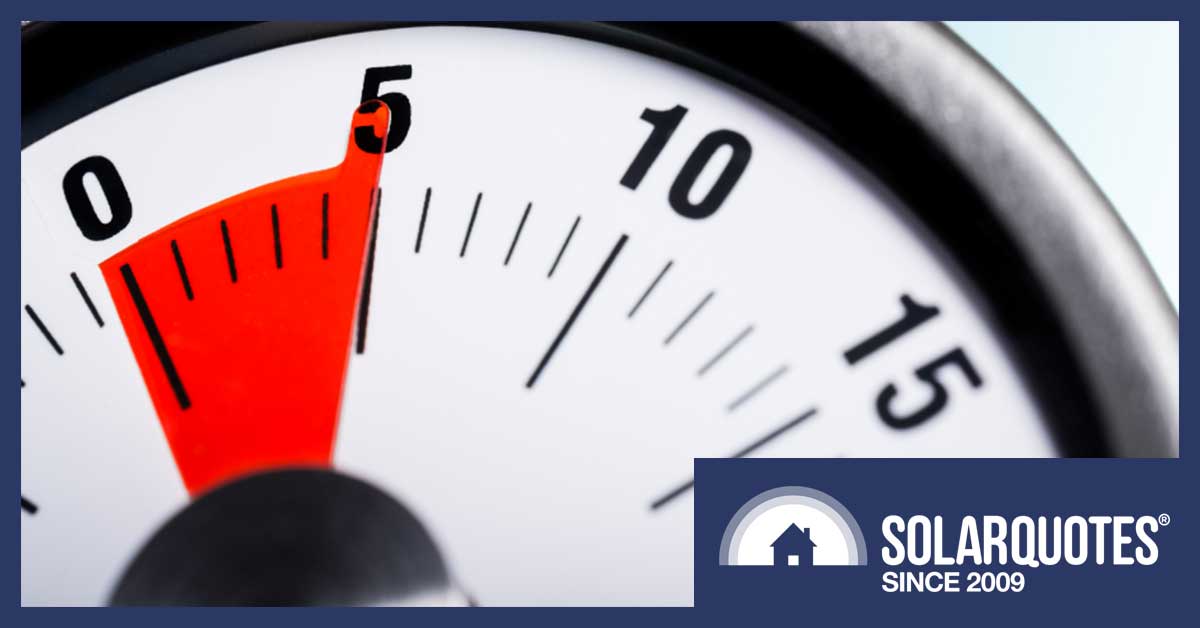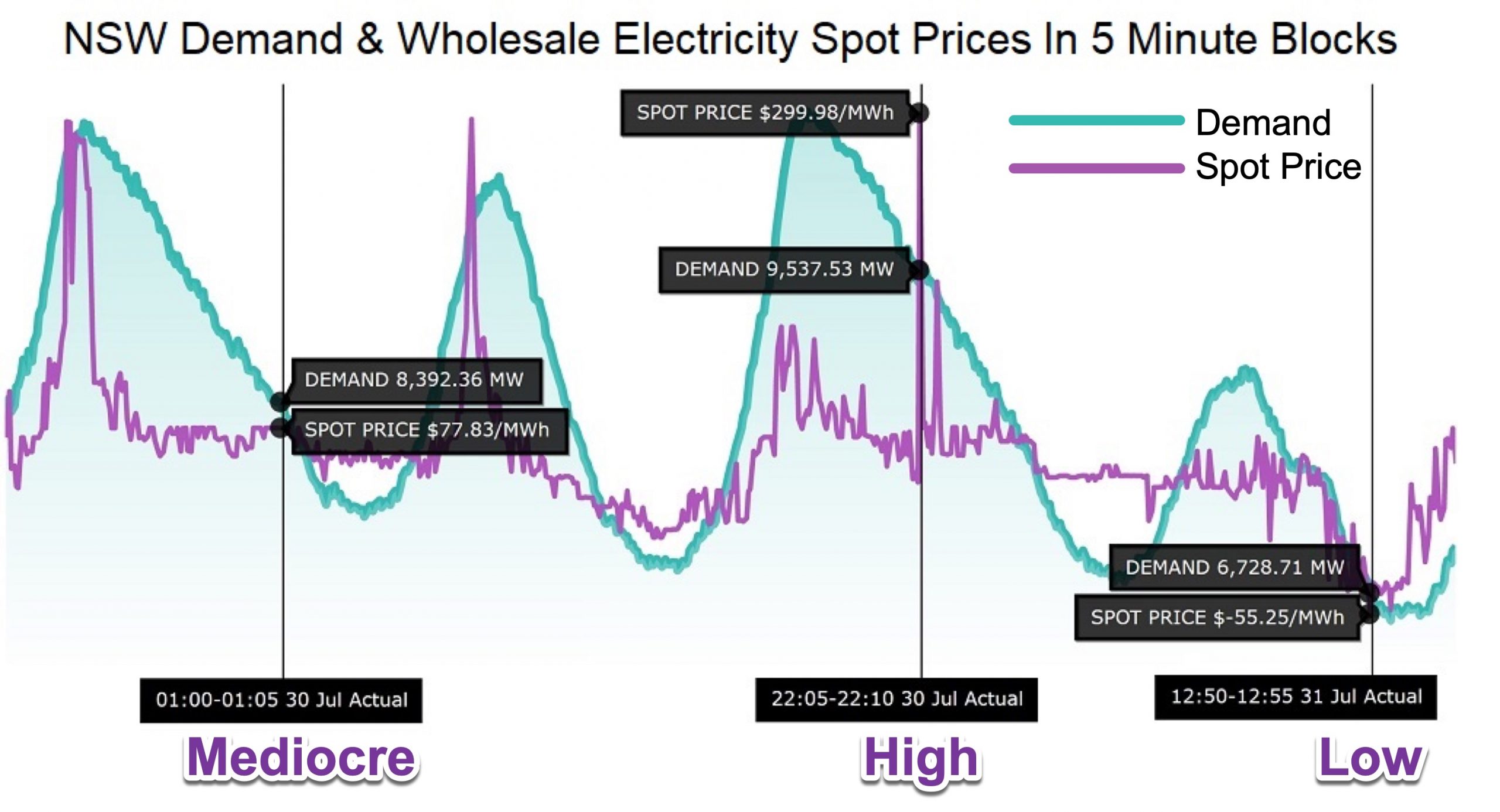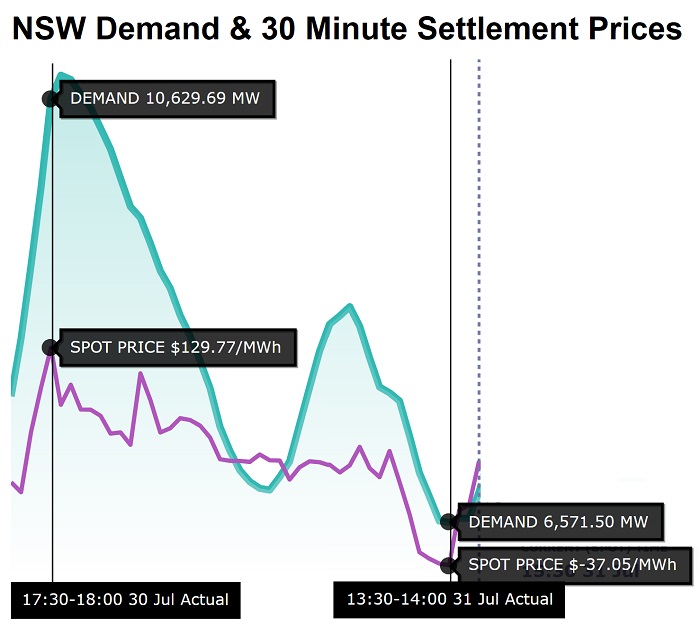
On October 1st, Australia’s National Electricity Market is changing from 30-minute to 5-minute settlement.
In this article, I’ll explain exactly what Australian households need to do to prepare for this event. This is easy because what’s required is…
…absolutely nothing.
While all grid users will benefit from the coming change, there’s nothing households have to do. Unless you’re in the business of selling wholesale electricity, you can chill.
But if you happen to own a coal power station, you are permitted to sob with impotent rage. This is because, a sweet, long-standing arrangement favouring fossil fuels will disappear. If you find you’re physically incapable of crying, please feel free to crack open one of your finest bottles of orphan tears.
While consumers won’t need to do anything, benefits from the change will include…
- Lower electricity prices.
- Higher profitability for utility-scale batteries and Virtual Power Plants (VPPs).
- Increased benefits to households from joining a VPP.
- More battery capacity. This will aid the integration of renewables into the grid and increase the pace fossil fuels are phased out.
- Create opportunities for households to save money use smart home energy management in the (hopefully) near future.
Update August 5th 2021: The AEMO (Australian Energy Market Operator) now says 5 minute settlement may be further delayed than it is already. It may not start until early 2022.
What’s A Settlement Period?
In Australia’s National Electricity Market — or NEM to its friends — the dispatch of electricity by larger generators is based on 5-minute periods. This is a convenient length of time because, barring disaster, electricity demand doesn’t change fast enough to cause problems over the time it takes Yoda to sing about his stick.
This graph from the AEMO shows electricity demand and wholesale electricity spot prices for the 5 minute dispatch periods. It covers three days in NSW ending at 3:30 pm on Saturday, July 31st.

On the graph, spot prices are given as dollars per megawatt-hour. Divide those numbers by 10 to get cents per kilowatt-hour.
I’ve shown the spot price at three different points on the graph. From left to right they are…
- A mediocre price: 7.783 cents per kilowatt-hour
- The highest price: 29.998 cents per kilowatt-hour
- The lowest price: -5.525 cents per kilowatt-hour
The lowest price is interesting because it’s negative. This occurs when there is too much electricity being supplied to the grid and forces generators to pay to generate. This encourages them to generate less electricity. While generators don’t like negative prices, large businesses and some households exposed to wholesale electricity prices enjoy being paid to consume electricity.
Anyone with a battery who can buy and sell electricity at the spot price of these 5-minute blocks clearly has an incentive to charge that battery when prices are negative and sell the stored energy when the price is high. This way they make money both coming and going.
But at the moment generators aren’t paid in 5-minute blocks. Instead, the 5-minute prices are averaged over 30 minutes. This is known as 30-minute settlement. The graph below shows 30-minute settlement prices over a 24 hour period in NSW:

This graph for NSW covers 24 hours ending at 3:30 pm on Saturday, July 31st. So it’s the same period of time as the right third of the previous graph.
The highest and lowest 30-minute settlement prices are shown on the graph. This is what generators are paid for all the energy they supply in a half-hour period. Because they’re an average of six blocks of 5 minutes each, these prices are less extreme. In other words, the highest price isn’t as high and the lowest price isn’t as low.
| Highest Price c/kWh | Lowest Price c/kWh | |
|---|---|---|
| 5-minute settlement | 29.998 | -5.525 |
| 30-minute settlement | 12.977 | -3.705 |
30-minute pricing benefits sluggish generation such as coal power plants, while screwing over fast-acting energy storage such as batteries.
Why 30 Minute Settlement?
Back in 1998 when the National Electricity Market came into official existence, 30-minute settlement was selected over 5-minute settlement, despite the shorter period looking like the logical choice.
One reason given is for this is communication technology wasn’t as advanced back then. But I suspect the choice was mostly based on conservatively copying overseas electricity markets overseas that worked, along with an arse-covering aversion to trying something new. I also believe little or no consideration was given to the potential future role of renewables or energy storage.
Rather than design a system from the ground up where pay-period and electricity-dispatch periods were the same, it’s now being fixed 23 years later. That seems a bit bloody long to me. The decision wasn’t made until the 28th November 2017, and came about thanks to large electricity consumers complaining about being ripped off by generators. The introduction date was then delayed three months on account of COVID and so is now starting October 1st.
Benefits Of 5 Minute Settlement
This AEMO factsheet gives three benefits of introducing 5-minute settlement. I’ll introduce them one at a time:
With 5-minute settlement, more nimble and flexible generators will have an advantage over Australia’s old, inflexible coal generation. Batteries will have an advantage over all fossil fuel generation because, as this article describes, all fossil fuel generation has:
- Start-up costs
- Start-up times
- Minimum levels of stable output
None of these issues applies to batteries, thanks to having no moving parts. This lets them react far faster than any fossil fuel generator and immediately take advantage of 5 minute periods of high or low electricity prices.
As batteries are no longer held back by a pay period custom made for fossil fuel plodders, they will be more profitable, so companies will build more. It’s no accident the world’s largest battery is scheduled for completion in Victoria on November 1st, one month after 5-minute settlement is introduced1. Increased battery capacity hastens the rate cumbersome old fossil fuel capacity is shut down.
Demand response is when electricity users change consumption in response to prices. It’s difficult for a business to turn off air conditioning or refrigeration for 30 minutes, but it’s easy for a 5 minute high price period. It’s also easy to do the opposite and crank up air conditioning, refrigeration, and other consumption during a five minute low price period.
The behaviour change this encourages will lower electricity costs for large businesses, while also reducing how extreme the price differences are between 5-minute settlement periods.
This is a polite way of saying it will make it harder for generators to game the system to their own advantage. When a large generator gains sufficient market power thanks to a supply constraint or lack of competition, a common tactic is to bid at a sky-high price for five minutes and then rock bottom prices for the rest of the half-hour.
The lower prices ensure most of their generation is used, but the sky-high 5 minute bid increase the price paid to the generator when averaged over the half-hour. It is, of course, consumers who end up paying, so we’ll benefit from lower electricity prices once this cheat code is eliminated.
Big Batteries & VPPs To Benefit
Only large utility-scale batteries and VPPs can directly benefit from 5-minute settlement. I’m not aware of any home battery system that allows households to benefit without being a member of a VPP. One indirect benefit to households is payments VPPs offer those who join should increase, as they’ll be able to make more money from exploiting other people’s batteries.
Battery households that don’t join VPPs may be worse off. 5-minute settlement will increase the amount of battery capacity on the grid, potentially reducing the price difference between peak and off-peak rates. The smaller the difference, the lower the return from home batteries using these tariffs.
In the future, we may see smart home battery and energy management systems that give households the lion’s share of VPP profits to the household – not the VPP operator. That would be nice, but I don’t recommend holding your breath.
Footnotes
- It remains to be seen if the opening of the Victorian Big Battery will be delayed due to the recent fire that occurred during testing. ↩




 RSS - Posts
RSS - Posts



Hi Ronald, I’m not sure how this benefits those of us without a battery. I can see how the retailers would like lower prices but I can’t see them passing them on to us. Also the largest retailers are vertically linked to the fossil generators. The only advantage I can see is the removal of fossil fuel generators.
It will result in a slight decrease in electricity prices. Partly because it will stop large generators gaming the system and because it will result in more economically efficient generation and use of electricity. It is a heavily regulated business so they will be forced to pass savings on.
Tut tut …. Origin Energy have just advised price rises in Victoria…Mostly “Network charges” apparently…This hot on the heels of an Essential Services Commission approval to substantially reduce feed in tariffs because of considerable drop in wholesale electricity prices. Please stop being apologists for this grubby industry.
Ronald, I get where the system is heading but if the fossil guys decided to reduce output to about the required nightly load and as a result drive up the price of electricity (profits) throughout the day what is to stop them? If you follow the NEM it is easy to see the changes as a result of the recent significant failure in one turbine so a couple more would tighten the market considerably with few short term alternatives? My point is that it seems that there may be more ways to game the system at least in the short to medium term until renewables put the dinosaurs to bed for good?
Well, they’re already using every trick in the book to increase their profits, so removing one trick will only help. And anything they do to raise electricity prices increases the profitability of solar, wind, and battery storage and encourages more of their capacity to be built, so if fossil fuel generators keep prices low to discourage renewable investment, consumer electricity bills benefit. If they charge as much as they can get away with, the planet benefits. Experience leads me to suspect they’ll do as much of the latter as they can.
In Victoria brown coal power plants provide the baseload and supplied over two-thirds of power generated last year. Ownership of these plants is split between AGL (Australian listed public company), China, and Japan (minority partner).
In NSW black coal provided over three-quarters of power generated last year with AGL, Origin (another Australian listed public company), and China owning the power plants.
In Queensland black coal provided over three-quarters of the electricity generated last year. Most power plants are owned by one of two state owned corporations.
Thus the Australian electricity markets are already reliant on coal, and tricks to increase profit will primarily accrue to either Australian companies or state governments. Solar farms by contrast are primarily foreign owned.
There’s also the question of how a platinum plated grid affects prices. I dimly recall reading somewhere that excessive investment in the grid has driven costs up, which results in higher electricity prices. While I can’t recall what or where I read the original story, per an older ABC article “Two-thirds of the grid operators’ income comes from earnings guaranteed by the regulator linked to the value of their networks.” In other words the more capital is invested in networks the more they can charge customers irrespective of the actual usefulness of those investments. Hypothetical NEM savings are thus only one aspect, and in Queensland at least, unlikely to make any difference given it is the state making and regulating profits.
Oh side thought, just how agile are Australia’s ageing coal plants? Can they ramp up to meet 5 minute unit demands? Or are they likely to be effectively locked out and thus ignore changing market demands? Might this lead to more blackouts? Home solar does squat when the power stops – unless you have an armageddon proof system. 🙁
If you are signed up to a VPP opertor that doesn’t already give you, the customer, the lions share of the profits freom your battery, then you are with the wrong VPP operator.
Well in fact it is a little more complex than that now.
The AEMO has recently released a draft ruling that effectively will stop VPPs participating in the FCAS market. This draft ruling is (i believe) open for comment until October.
Essentially this will mean that the hidden income that most VPPs earned through FCAS – which was used to subsidise their battery offerings will be taken off the table in the very near future.
As such you would have noticed that many of the VPP companies have removed any info about their VPPs from their websites whilst they asses how to approach this.
Obviously the 2nd level VPPs that you just sign up for – such as Discover and others should still be viable – but i think their revenue split will have to change if they can not rely on FCAS revenue to subsidise their admin overheads etc
How would this work for us in WA where batteries are locked from discharging between 10 am and 4 pm and where flow in and out of the battery is restricted by software to 3 kWh. I can not use a full battery even for in home consumption between 10 am and 4 pm. These are thecrestrictions that make batteries in WA useless and show the monopoly danger of having just 1 supplier in the state.
Johan, we have a 13.5kWh battery in Perth and it will supply all the power that it has available at any time up to about 5kW at any time day or night for self use. I get that particularly in summer in WA and clear sunny autumn days the grid does not want people exporting from a battery as solar production is very high at these times. Are you sure that it is not just an internal setting in your battery that is giving you issues during the day?
Dear Mr Brakels, it is a brave person that attempts to divine future outcomes.
You said “While consumers won’t need to do anything, benefits from the change will include…
Lower electricity prices.”
Upon reflection and with the passage of time has this occurred, specifically lower electricity prices, in your view?